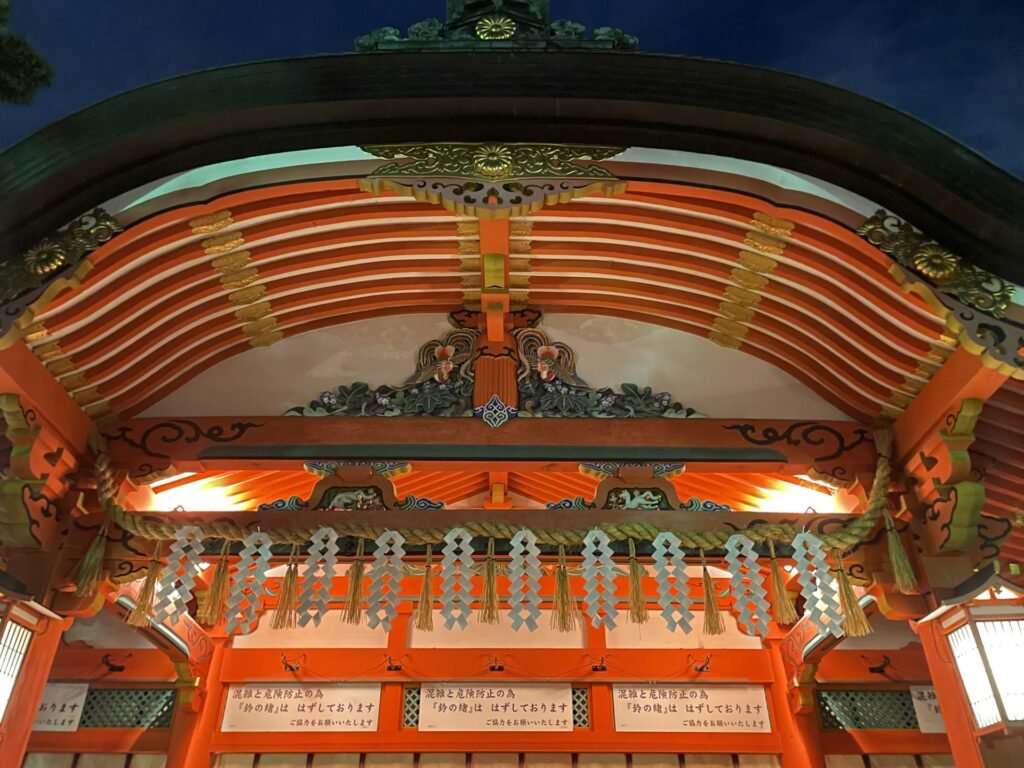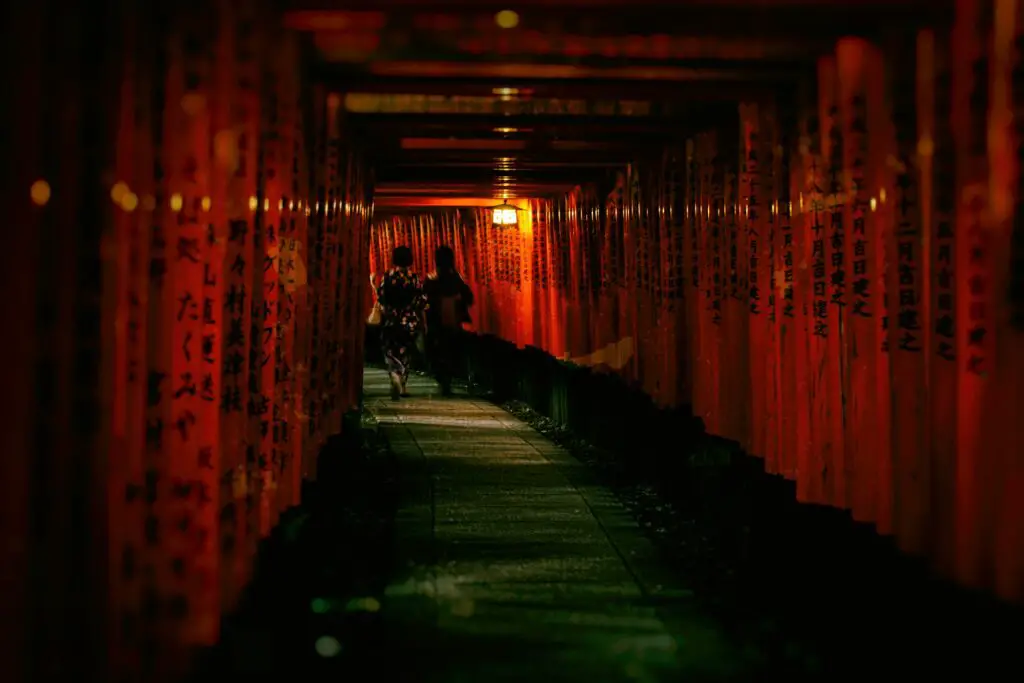Did you know that Fushimi Inari Shrine in Kyoto, Japan, is said to have over 10,000 vibrant orange torii gates lining its pathways?
As you stroll through this iconic Shinto shrine, you will immerse yourself in a world of spiritual significance and cultural beauty.
The intricate details of each gate and the mystical atmosphere surrounding the shrine make it a truly unique destination worth exploring.
What is Fushimi Inari Shrine?
Fushimi Inari Shrine, located in Kyoto, Japan, is a historic Shinto shrine dedicated to Inari, the god of rice and prosperity.
The shrine complex is renowned for its thousands of torii gates, which create mesmerizing tunnels that lead through the sacred Mount Inari.
The serene atmosphere invites you to reflect, meditate, and appreciate the beauty of nature surrounding you. If you seek blessings for prosperity, success, or a bountiful harvest, this sacred site is the perfect place to express your gratitude and hopes.
Remember to approach each moment with reverence and mindfulness, embracing the spiritual essence that permeates the air at Fushimi Inari Shrine.
Where is Fushimi Inari Shrine Located
The shrine is conveniently located just a short train ride from Kyoto Station, making it easily accessible for visitors.
Once you arrive, you’ll be greeted by the famous torii gates that mark the entrance to this historic and spiritual site.
How to Get There

If you’re planning to visit beautiful Japanese shrines, Here’s a step-by-step guide on how to get to Fushimi Inari Shrine:
- Arrive in Kyoto: First, make your way to the city of Kyoto, located in Japan’s Kansai region.
- Head to JR Inari Station: From Kyoto Station, take the JR Nara Line (Biwako Line) to JR Inari Station. The journey takes approximately 5 minutes and is covered by the Japan Rail Pass.
- Exit the Station: Upon arrival at JR Inari Station, follow the signs to the exit and proceed to street level.
- Follow the Signs: Look for signs directing you to Fushimi Inari Shrine. The shrine is just a short walk from JR Inari Station, and clear signposts guide visitors along the way.
- Enter the Shrine Grounds: As you approach Fushimi Inari Shrine, you’ll pass through the main entrance gate, the Romon Gate. Enter through the gate and continue along the path leading into the shrine grounds.
- Explore the Shrine: Take your time to explore the various structures, sub-shrines, and torii gates within the expansive grounds of Fushimi Inari Shrine. Be sure to follow the designated paths and respect any roped-off areas.
- Climb Mount Inari: If you’re feeling adventurous, consider hiking up Mount Inari to reach the summit. Follow the network of trails lined with thousands of torii gates, and enjoy the scenic views along the way.
- Return to JR Inari Station: After exploring the Fushimi Inari Shrine to your heart’s content, return to JR Inari Station following the same route you took to arrive at the shrine.
- Depart from Kyoto: If you’re returning to Kyoto Station or heading elsewhere in the city, board a train at JR Inari Station and follow the appropriate route for your destination.
Rituals and Customs Observed at Fushimi Inari Shrine
As you explore the Fushimi Inari Shrine in Kyoto, you’ll encounter various rituals and customs unique to this sacred place. Check out the rituals that you should observe and follow:
The Offering of Torii Gates
At Fushimi Inari Shrine in Kyoto, visitors offer torii gates as a symbol of respect and gratitude. You can make an offering as you walk along the winding paths lined with thousands of vibrant red torii gates.
Each torii gate represents a donation made by individuals or businesses to the shrine. By contributing to a torii gate, you show appreciation for blessings received or seek favors for a wish or prayer.
Hand Washing
Upon approaching the purification fountain at Fushimi Inari Shrine, you’ll encounter the traditional hand-washing ritual, a significant custom visitors observe before entering the sacred grounds.
This act symbolizes the purification of the body and mind, showing respect for the spiritual realm you’re about to enter.
Clapping and Bowing
When approaching the main shrine at Fushimi Inari Shrine, remember to clap and bow as a sign of respect and reverence. This simple act of clapping twice and bowing deeply is a way to show your gratitude and honor the spirits residing in the shrine.
As you stand before the main shrine, gently clap your hands twice to capture the attention of the kami, the spirits believed to inhabit the shrine. Then, lower your head in a deep bow as a gesture of respect.
Fox Statues
Exploring the Fushimi Inari Shrine in Kyoto reveals a rich tapestry of rituals and customs, prominently featuring the revered Fox Statues.
These statues, known as ‘Kitsune,’ represent the messengers of Inari, the Shinto deity of rice and prosperity. Visitors often observe people bowing, clapping, and praying to these fox statues, seeking blessings for business success, fertility, or protection.
Walking the Trails

As you traverse the trails at Fushimi Inari Shrine, immerse yourself in the rituals and customs that symbolize a profound connection to nature and spirituality.
Visitors often participate in a cleansing ritual at the chozuya, purifying their hands and mouths before entering the sacred grounds.
As you walk under the iconic Senbon Torii, each gate marking a transition into a sacred space, remember to bow slightly as a sign of respect.
You may notice small altars and statues dedicated to Inari, the Shinto deity of rice and prosperity, along the trails. Take your time, reflect on your intentions, and pray at these spots to show reverence and gratitude for the blessings in your life. If you’re into hiking, don’t miss out on the beautiful hiking trails in Japan on your next visit!
Omikuji
Immerse yourself in the unique rituals and customs of Fushimi Inari Shrine by experiencing the tradition of omikuji, where visitors receive written fortunes that offer insights into their future.
Upon arriving at the shrine, seek out the omikuji stand, where you can make a small offering before selecting a random fortune slip. These fortunes range from excellent blessings to warnings of potential challenges.
Activities and Experiences in Fushimi Shrine
Aside from the activities you can do in Kyoto, check out the popular activities you can do in the Fushimi shrine:
1. Explore the Torii Gate
The vibrant vermillion gates create a path that winds through the forested hillside, inviting you to reflect and find peace in the tranquil surroundings. Passing under each gate, known as ‘Senbon Torii,’ you’ll feel a sense of reverence and connection to the shrine’s spiritual energy.
The act of walking through these gates symbolizes leaving behind the ordinary world and entering a sacred space, offering a moment of introspection and spiritual rejuvenation.
2. Hike the Trails
The hiking trails offer a serene retreat where you can connect with the tranquillity of the surroundings while engaging in physical activity.
As you tread along the paths lined with thousands of vibrant red torii gates, you’ll feel a sense of peace and rejuvenation wash over you. Remember to wear comfortable shoes and bring water to stay hydrated during your hike.
3. Take Photos
As you wander through the shrine, focus on the intricate details of the gates, the play of light and shadow, and the sense of reverence that permeates the air. Take your time to frame each shot thoughtfully, aiming to convey the physical beauty and deeper spiritual significance of this sacred place.
4. Sampling Local Cuisine
Treat yourself to traditional Japanese dishes like savory yakitori skewers, crispy tempura, and warm bowls of udon noodles. Don’t miss the opportunity to try matcha-flavored treats, such as soft and creamy ice cream or delicate matcha mochi.
Venture into cozy teahouses to experience a traditional tea ceremony or sample fragrant green teas. Grab freshly made onigiri rice balls from street vendors for a quick bite.
Conclusion
Visiting Fushimi Inari Shrine is a truly spiritual and unforgettable experience in Kyoto. The shrine’s serene atmosphere and beautiful torii gates create a sense of peace and tranquillity.
By participating in rituals and customs, you can truly immerse yourself in the spiritual heart of this sacred place. Remember to follow the tips to make the most of your visit and explore the nearby attractions to complete your journey in Kyoto.
Frequently Asked Questions (FAQs)
What is special about the Torii Gates at Fushimi Inari?
The Torii gates at Fushimi Inari are known for their vibrant vermilion color and represent entrances to sacred spaces, with the shrine boasting thousands of Torii gates along the mountain trail.
How long does it take to explore Fushimi Inari?
Exploring Fushimi Inari typically takes around 2-3 hours to stroll through the torii gates, visit the shrine’s grounds, and enjoy the panoramic views.
What are some must-see sights at Fushimi Inari Shrine?
While at Fushimi Inari Shrine, don’t miss the Main Shrine, the Senbon Torii (thousands of Torii gates), and the fox statues, which are messengers of Inari.
Is Fushimi Inari Taisha Shrine dedicated to a specific deity?
Yes, Fushimi Inari Taisha Shrine is dedicated to Inari, the deity associated with success, prosperity, and fertility in Japanese Shinto beliefs.









